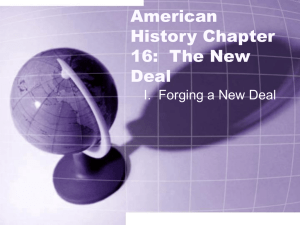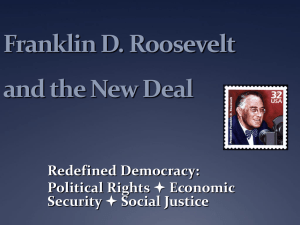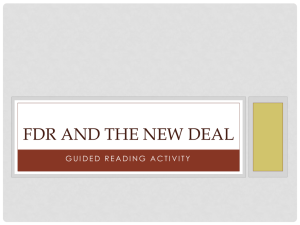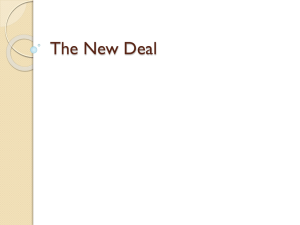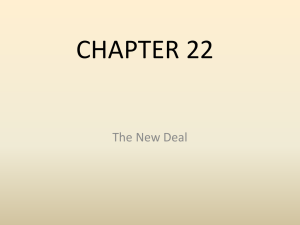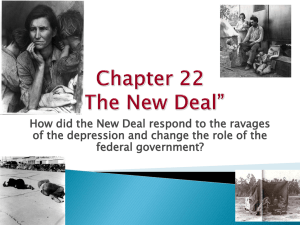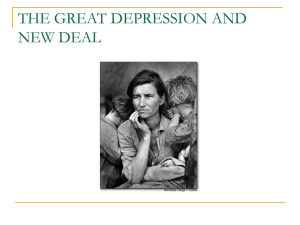Franklin D. Roosevelt and the New Deal
advertisement
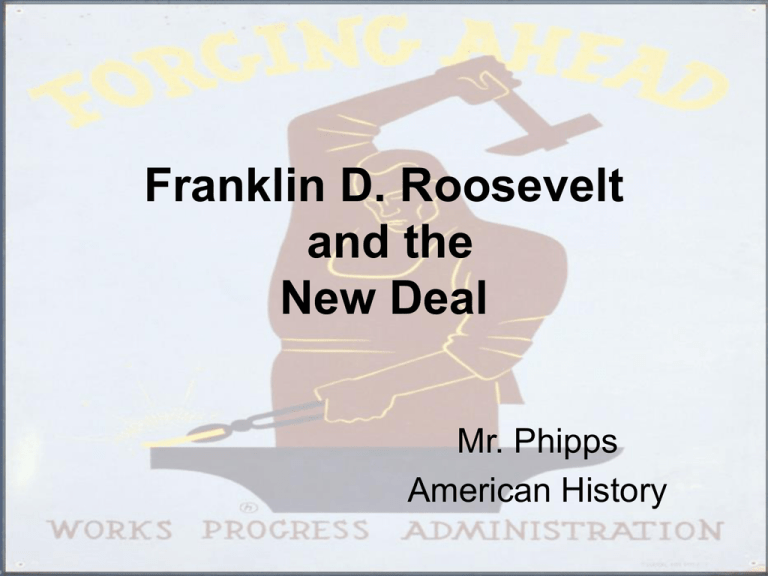
Franklin D. Roosevelt and the New Deal Mr. Phipps American History California State Standards 11.6.2. Understand the explanations of the principal causes of the Great Depression and the steps taken by the Federal Reserve, Congress, and Presidents Herbert Hoover and Franklin Delano Roosevelt to combat the economic crisis. 11.6.4. Analyze the effects of and the controversies arising from New Deal economic policies and the expanded role of the federal government in society and the economy since the 1930s (e.g., Works Progress Administration, Social Security, National Labor Relations Board, farm programs, regional development policies, and energy development projects such as the Tennessee Valley Authority, California Central Valley Project, and Bonneville Dam). The Era • The Great Depression was a prolonged period of widespread poverty and unemployment • In the United States, the federal government responded by increasing its power and influence • The First and Second New Deals attempted to provide RELIEF, RECOVERY, and REFORM • FDR was criticized for abusing Executive Authority and not ending the Depression • Mobilization for war the ultimate reason for ending global depression Part I: The Election of 1932 The Election of 1932 was a referendum on the Republican Party, on conservative government, laissez-faire-ism, and Herbert Hoover. The Election of 1932 Herbert Hoover (Rep.) • Conservative politician – Believed that federal government should stay out of people’s lives – Government should not fix individual problems – Direct relief would destroy self-reliance and self-respect – Believed that a “big government” was an abuse of power and “Socialist” Franklin D. Roosevelt (Dem.) • Liberal politician – Believed that federal government had responsibility to help people – Capitalism, corporate entities, and financial/banking structure needed to be reformed – Government involvement was necessary and ensured access of Democracy to all Americans The Pledge FDR’s Campaign Pledge • Promised a “new deal for the American people • Vowed relief, recovery, and reform • Pledged an end to Prohibition • Won by the greatest electoral landslide in history While it is tradition for the outgoing president to be a part of the incoming president’s inauguration, it was rare for both presidents to be in the same car for the procession to the Capitol. For his inauguration, FDR “asked” Hoover to accompany him. FDR’s glee is matched only by Hoover’s obvious discomfort. “Sunny Days Are Here Again” Experience • Two term governor of New York • Cousin to Theodore Roosevelt • Had strong, well-established political family ties • Married to Eleanor, also a distant cousin Election of 1932 • Dramatic upheaval in Congress – Democrats controlled both houses of Congress – Greatest change in Congress in 80 years Part II: The First Hundred Days Lasting from March to June, FDR took broad Executive Authority to enact legislation that would end the Depression. FDR’s New Deal Philosophy The Three Rs • Relief: Provide immediate help • Recovery: Provide long-term help and begin economic growth • Reform: Change government so it wouldn’t happen again The Plan • • • • • Renew hope in democracy Restore confidence in banking Stimulate the economy Put people back to work Restore self confidence The Democratic Congress QuickTime™ and a TIFF (Uncompressed) decompressor are needed to see this picture. • Within the first 100 days, Congress passed over 15 major legislative packages • All 15 were signed by FDR, although some were later challenged by the Supreme Court as unconstitutional • Constituted the largest and fastest expansion of federal power in American history The Alphabet Agencies Part III: The Three Rs During the First and Second New Deals, FDR enacted legislation that provided jobs, public services, relief from foreclosure, and reformed the financial system…at the cost of billions of dollars. Step 1: Help Banks • First priority: Restore confidence in banking • Declared a “Bank Holiday” – Banks closed to evaluate records and get more money • Passed Emergency Relief Act, allowing the President (through the Treasury) to inspect the banks Insurance • FDR passed the Glass-Steagall Act – Established FDIC (Federal Deposit Insurance Corp.) – Ensured account holders up to $5,000 (now $100,000) Step 2: Provide Relief • FERA (Federal Emergency Relief Agency): – Gave $500 million of direct aid relief to unemployed workers, provided food, clothing, and grants to cities • FHA (Federal Housing Authority): – Provided home loans, home mortgages, and grants for repairs The Boys of the Road • CCC (Civilian Conservation Corps): – Sent 3 million young men (18-25) to work in forestry, trail maintenance and construction, construct bridges and aqueducts, conserve natural – Removed surplus of young men from cities and guaranteed income for Pay checks would be forwarded directly to their families the families. Since the boys of the CCC had free room and board, the pay would help needy families back home. Public Works • PWA (Public Works Administration): – Part of the National Industrial Recovery Act – Provided money and jobs to construct schools, community buildings, and other public projects – Gave $3.3 Billion in aid • CWA (Civil Works Administration) – Constructed 40,000 schools, paid for 50,000 teachers – Built 500K miles of road – Hired over 4 million workers “Three Letters That Make it OK” • WPA (Works Progress Administration) – Employed 8.5 million workers – Provided jobs in construction, public works jobs (bridges, roads, buildings, highways) – Supported the Arts • • • • The Federal Arts Projects The Federal Music Project The Federal Theater Project The Federal Writers Project (including oral history) When the WPA finally shut its doors, it had completed 2,500 hospitals, nearly 6,000 schools, 13,000 playgrounds, and over 125,000 public buildings. In addition, it constructed HWY 1 in California and started the Golden Gate Bridge. While praising the accomplishments and supporting authors like Steinbeck, Hurston, and Hughes, the WPA’s Writer’s Project also interviewed thousands of surviving former slaves, in the hope of preserving their experience for posterity. Step 3: Recovery Programs • HOLC (Home Owners Loan Corporation): – Prevent mortgage foreclosures – Gov’t bought mortgages and allowed for refinancing • NIRA (National Industrial Recovery Act): – Enforced codes of fair market competition – Established minimum wage – Permitted collective bargaining and union negotiation QuickTime™ and a TIFF (Uncompressed) decompressor are needed to see this picture. The TVA • TVA (Tennessee Valley Authority): • Regional development-upper South was deeply impoverished • Stimulate the economy by providing jobs • Flood control • Produce cheap electricity 30% of property owners in the region had no toilets, compared to 41% of tenants. 94% of property owners didn’t have electricity, compared to 98% for tenants. A Long Range Plan • Nearly 3/4 of all people in the upper South had to travel at least 300 yards to get household water • Less than 10% of these people owned a radio due to poverty and availability of electrical power • Less than half of all the property owners could read, less than 1/4 of poor whites and blacks Step 4: Reform • SSA (Social Security Administration): – Established retirement pension for persons over 65 – Money deducted automatically from payroll – Provided old age insurance and unemployment compensation Financial Reform • SEC (Securities and Exchange Commission): – Regulated Stock market and restricted margin buying, fraud, and insider trading • NLRB (National Labor Relations Board): – Protected labor unions, prohibited unfair labor practices, affirmed workers’ rights Part IV: FDR’s Critics Because of his unprecedented use of Executive Authority, FDR encountered much criticism: from the Supreme Court, from Conservatives, and from people who had yet to be helped. FDR Gets It From Both Sides • Although the New Deal helps many people, critics emerge • Liberals: – Felt that FDR and the New Deal was NOT doing enough for the American people • Conservatives: – Felt that government was doing TOO much – Believed that the President had overstepped his Constitutional authority – Felt that government was spending too much money that couldn’t be paid back – Created a welfare state--dependency on the gov’t “Court-packing” • Court challenges FDR by striking down: – NIRA: too much control over industry (Schecter v. United States--the “Sick Chicken Case” – AAA: agricultural issues were local matters • FDR attempted to set age limits for Supreme Court justices, in order to ensure no opposition to New Deal – FDR successfully appointed 7 new justices to the Supreme Court Demagoguery • Huey Long – Louisiana Governor – Considered the “Most Dangerous Man in the World” – 4 million followers – Constantly railed against FDR as incompetent • Father Charles Coughlin – Advocated greater assistance to the poor – 45 million listeners Part V: A New Deal Coalition FDR’s promise of a “New Deal for the American people” resulted in greater political, social, and economic access for minorities and women. The First Lady • Eleanor Roosevelt – Helped women gain higher political positions during the New Deal – Was influential in her role as advisor to the President – Hired first female Cabinet position: Frances Perkins – Personally replied to letters from Americans (estimated 5,000--8,000/wk) – Personalized politics and feminized the New Deal The New, New Negro • The Black Brain Trust – Witnessed increased activism for black Americans – A. Philip Randolph becomes head of first allblack labor union (Brotherhood of Sleeping Car Porters) – Mary McLeod Bethune headed the Division of Negro Affairs for the NYA – Overall, FDR appointed over 100 AfricanAmericans to federal jobs Native Americans • Granted full citizenship in 1924 • Reorganization Act of 1934 gave more natives more control of their reservations • Policy shift from assimilation to autonomy Part VI: 1930s Culture Hollywood attempts to gloss over the Depression with big-budget pictures, while writers detail the personal tragedy of the decade. Hollywood and the Studio System • Large studios centralized production – Provided necessary funding during the Depression – Allowed for bigger productions, with a bigger budget – Provided systematic organization, from production to theatrical release (studios owned theaters) – Maintained contracts with individual actors and directors • Transition to sound (The Jazz Singer, first talkie) – Required re-investment in new technology on all levels of production – Development of new genres: crime, caper, comedy, musical, horror, epic, and noir • Actresses: Greta MGM Garbo, Joan • Crawford, Jean Harlos • Actors: Clark Gable, Mickey Rooney, Spencer Tracey Genre: Glitz, Glamour, Big Productions, Epics, and Noir Paramount Pictures • Actresses: Marlene Dietrich, Mae West • Actors: The Marx Brothers, Gary Cooper, Cary Grant • Directors: Cecil B. DeMille • Genre: Humor, Suave and Sophistication Warner Bros. • Actresses: Bette Davis, Barbara Stanwyck • Actors: James Cagney, Humphrey Bogart • Genre: Working Class Grittiness, Noir, Crime Dramas Twentieth Century Fox • Directors: John Ford • Actresses: Shirley Temple, Loretta Young • Actors: Henry Fonda • Genre: Historical Epics RKO • Actresses: Katherine Hepburn, Ginger Rogers • Actors: Fred Astaire • Directors: John Ford • Genre: Musicals, Adaptations, Style and Sophistication Universal Studios • Actors: Bela Lugosi, Boris Karloff • Genre: Horror, Melodrama, LowBudget Other Studios Radio • Radio sales increased from 13 million in 1930 to 28 million in 1940 • Approx. 90% of American households had a radio • Used as a means for FDR to directly communicate with the people through the “Fireside Chat” Radio Shows • Popular radio programs included Jack Benny, Burns and Allen, and Bob Hope • Orson Welles’ “War of the Worlds” shocked Americans with the threat of a Martian invasion, causing mass hysteria Art • Funded by the WPA, through the Federal Art Project • Subsidized by wealthy philanthropists (eg. Rockefellar Center) • Famous artists include Edward Hopper, Thomas Hart Benton, and Grant Wood Grant Wood: Fall Plowing (1931) Grant Wood: American Gothic, 1930 Edward Hopper: Nighthawks (1942) Edward Hopper: Railroad Sunset (1929) Mabel Dwight: In the Crowd (1931) Thomas Hart Benton: Mine Strike (1933) Thomas Hart Benton: Lord, Heal the Child (1934) Nicolai Cikovsky: On the East River (c. 1934) Literature • The Federal Writer’s Project funded authors • Both Richard Wright and John Steinbeck received federal assistance for their projects • Both authors, among others, captured the spirit of the times Conclusion • FDR received criticism from both Liberals and Conservatives – Liberals argued that he didn’t do enough to end the Depression, which is why it continued to linger until 1939 – Conservatives argued that he abused Executive Authority in implementing the New Deal and ran up a gigantic national debt • The New Deal failed to completely address the economic, social, and political problems of the Depression but did – Provide millions of jobs – Construct roads, bridges, dams, and public buildings – Reformed the government to provide direct assistance to children, the unemployed, the homeless, the disabled, and the elderly


